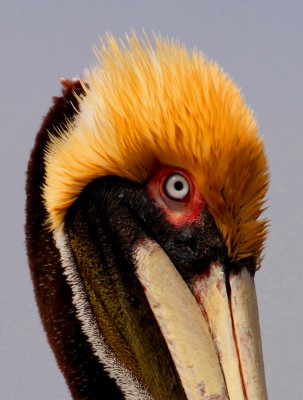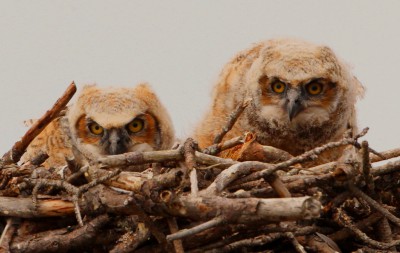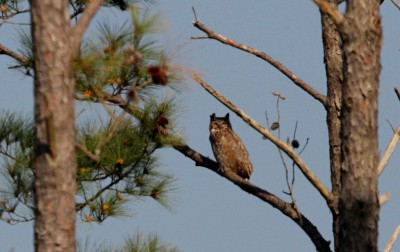ORIENTAL–With one foot in the kayak and the other on the dock, I pushed off like a kid propelling a skate board. I settled into the seat, slowly gliding away from the dock. Dipping the paddle into the water, I looked back to make sure the marina owner’s friendly pooch wasn’t swimming after me. The equally friendly owner graciously allowed me to launch my kayak from his dock in the lowlands of Pamlico County. I was off to find two active bird nests of a great horned owl and a bald eagle.
Moving through the clear water, I lifted the paddle too high a few times causing the water to run down the length of the bar soaking my hands. I was surprised at the coolness of the water on this sunny March morning. The short channel from the dock emptied into Broad Creek, which flows into the lower Neuse River just before reaching the big water of the Pamlico Sound.
Supporter Spotlight

Out on Broad Creek, a blue crab fisherman checking his crab pots meandered from float to float as if playing a game of connect the dots on the water. A group of brown pelicans glided above and behind the fisherman’s boat as if they were kites tethered to the stern. As the crabber retrieved each pot, the pelicans hovered in the air for a few seconds before gently descending toward the water, optimistic for a taste of crab bait. Their calmness turned into an all-out wing-slapping scrum as they all lunged after the remains, their large sword-like bills snapping at the water.
One lone pelican stayed away from the fray, watching the commotion from the perch of a solitary piling. I paddled past the bird, and then allowed the current to drift the kayak back towards the piling. The bird faced me and stood erect as if showing off its elegant, golden breeding plumage that adorned the crown of its head. As I drifted past and around the piling, it kept its eyes directly on me without moving its head. It kept shuffling its feet to rotate its entire body, creating a Mona Lisa effect with its eyes following me.
I left the pelicans and paddled off to find the owl and eagle nests. Based on the word I received, a grand nest near the edge of the water, with large adult birds tending to the feeding of demanding chicks, will not be hard to find. Paddling against a moderate chop, I headed for a small tributary known as Green Creek. This is where I began my search for the nests in earnest and scoured the shoreline for any dead pine tree loaded with a bulky stick nest.
According to my reports, the great horned owls I was looking for had taken up residence in a year-old vacant osprey nest. Since they nest earlier in the year than ospreys, great horned owls don’t waste their energy building a nest. They simply take advantage of the opportunity. If the osprey returns to claim ownership, the fish hawk will usually yield to the trespasser.
I paddled in and out of the jagged shoreline unable to discover the nest at water level. So, I beached the kayak in a small sandy area and used a derelict duck blind as a viewing tower. Pointing my binoculars across to the distant shore I dialed in the focus rings as an osprey nest came into view. Staring directly at me was a white, fuzzy great horned owl chick, its penetrating yellow eyes piercing right through me. I couldn’t believe my luck. I viewed for a while from the opposite shore, observing only the lone chick cautiously raising its head to peek out over the rim of the nest. Its citrine eyes betrayed any chance of deception.
Supporter Spotlight

Unlike the shoreline near the marina, this area was uninhabited without a house in sight–just pine forest. I crossed the creek and directed the kayak into a thick growth of grasses that lined the shore about 50 yards from the nest. From here, I began my surveillance, sure that an adult owl would soon join the chick.
Off in the distance I could hear the sharp call of an osprey, maybe a protest to the owls. Its call returned many times throughout the day like an echo bouncing back from the past. I reclined in the seat of the kayak and waited. The wind was dying down its only footprint a slight ripple on the water. My concealment and stagnant posture soon lured a lesser scaup to land in the water only 20 feet away. It eagerly swam away as I raised my body to get a look at the owl nest. Two white heads now bobbled above the nest as they stretched their wings and stood more erect. Any movement from me caused them to swivel their heads and gaze with a death stare of four stern eyes. Since owl eyes are fixed in their sockets, the owl must rotate the entire head to follow movement. Folklore still persists that an owl can spin its head entirely around when in fact they are only able to rotate 270 degrees. Impressive, but not quite a complete circle.
As not to stress the birds, I pulled the kayak ashore and started hiking away from the nest and across the peninsula of land that the nest was on. Somewhere along these shores, between Green and Smith Creek, there once stood an ancient live oak tree known as Teach’s Oak. This landmark alluded to the pirate Blackbeard’s voyages into the Pamlico Sound. Though the tree is long gone, the legend still inspires treasure hunters to search for a mythical reward. I wasn’t looking for gold doubloons, but I was trying to reach the shoreline that meets the Neuse River to locate the eagle nest. I was quickly discouraged by the thick undergrowth that ripped open exposed skin, crawling ticks, soft mucky soil and numerous mosquito controlled ditches. I graciously gave up on spotting the eagle nest without any regret.

Off in the distance, I could hear the irritating sound of shouting crows. I smiled knowing that they had located at least one of the adult great horned owls, making it an easy find for me. Up on the sturdy branch of a pine tree, a riot of crows was attempting to mug the oblivious owl. Great horned owls are tough, powerful predators that shutter at nothing. These ferocious raptors view just about anything as prey, earning them the nickname “tiger owl.”
Unconcerned with the annoying crows, the owl went back to napping and the crows soon left. Without the crow’s assistance, I probably would have never seen the owl. Its cryptic camouflage of mixed patterns of brown and gray plumage blended well into the surrounding woods. Even its trademark ear tufts or “horns,” which have nothing to do with their hearing, helped break up the silhouette of its head.
The owls perch was not far from the nest with an unobstructed flight path to silently swoop down and defend its young if necessary. As I climbed back into my kayak I now had six strict eyes urging me to move on, so I did. Owls have long been a symbol of death or thought of as a bad omen while also an indication of intelligence and wisdom. On this day, I thought of none of this. I just enjoyed being in their presence, happy that they exist so that we can continue to contemplate their symbolism in our lives.
With the sun setting, the kayak effortlessly skimmed atop the smooth water as I paused for a few last looks. The downy owlet heads recoiled into the depths of the nest. The parent released its strong grip from the tree and swooped down over the marsh grasses, gliding into the silence of the approaching night.







